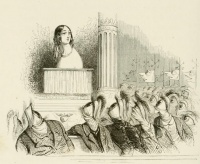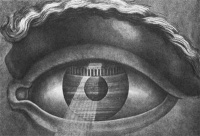Visual culture
From The Art and Popular Culture Encyclopedia
_by_Édouard_Manet.jpg)
|
Related e |
|
Featured: |
Visual culture, visual theory or visual studies are terms coined in the 1990s for an academic discipline that focuses on visual communication.
Contents |
Avant la lettre
While it is often taught that visual culture started with the rise of television, its origins can be traced further back. The age of visual culture starts with the age of printmaking, more specifically with the advent of woodblock printing in Europe in the 9th century. Printing is often associated with text, but the first print culture was in fact a very visual culture.
In Christian art, the need was felt to educate the illiterate by providing with pictures ("libri idiotarum" as they were called by some) in the form of paintings and sculptures and the illustrated bible known as the biblia pauperum.
As an academic discipline
Visual culture is a field of study that generally includes some combination of cultural studies, art history, and anthropology, by focusing on aspects of culture that rely on visual images. Among cultural studies theorists working with contemporary culture, this often overlaps with film studies and the study of television, although it can also include video game studies, comics, traditional artistic media, advertising, the Internet, and any other medium that has a crucial visual component.
Early work on visual culture has been done by John Berger (Ways of Seeing, 1972) and Laura Mulvey (Visual Pleasure and Narrative Cinema, 1975).
Major work on visual culture has been done by W. J. T. Mitchell, particularly in his books Iconology and Picture Theory. Other writers important to visual culture include Stuart Hall and Slavoj Zizek.
Notes towards a critique of visual culture as an academic curriculum
Several curricula of visual culture have been taught at English and American universities since the 1990s. While it is true that in the era after World War II, television has known a phenomenal rise in popularity, it would seem to me that in the early days of the so-called informational revolution, we were again moving to a textual Gutenbergian text-based cultures (email, messenger and search engines were the killer applications of the internet until the arrival of Youtube.
Mirzoeff argues that Modernism was a text-based culture, marked by the rise of novels and newspapers, But the rise of photography and the illustrated newspaper make it very much a visual culture. The illustrated newspaper was the television of its age and influenced impressionism to a large extent.
To the defense of visual culture as an academic curriculum, it must be noted that the discipline stresses the importance of the visual in cultural consumption, an approach which I appreciate in music too; an example of which is Ocean of Sound by David Toop, which celebrates music as an expression of aural culture. Incidentally, music is the only culture I know that is not visual culture, music is the only art form which is invisible.
History
Visual culture is a field of study that generally includes some combination of cultural studies, art history, critical theory, philosophy, and anthropology, by focusing on aspects of culture that rely on visual images. Among theorists working within contemporary culture, this often overlaps with film studies, psychoanalytic theory, gender studies, queer theory, and the study of television; it can also include video game studies, comics, traditional artistic media, advertising, the Internet, and any other medium that has a crucial visual component. Because of the changing technological aspects of visual culture as well as a scientific method-derived desire to create taxonomies or articulate what the "visual" is, many aspects of Visual Culture overlap with the study of science and technology, including hybrid electronic media, cognitive science, neurology, and image and brain theory. It also may overlap with another emerging field, that of "Performance Studies." "Visual Culture" goes by a variety of names at different institutions, including Visual and Critical Studies, Visual and Cultural Studies, and Visual Studies.
Early work on visual culture has been done by John Berger (Ways of Seeing, 1972) and Laura Mulvey (Visual Pleasure and Narrative Cinema, 1975) that follows on from Jacques Lacan's theorization of the unconscious gaze. Late nineteenth-century practitioners of visual knowledge, such as Georgy Kepes and William Ivins, as well as iconic phenomenologists like Maurice Merleau-Ponty also played a role creating a foundation for the discipline.
Major work on visual culture has been done by W. J. T. Mitchell, particularly in his books Iconology and Picture Theory and by the art historian and cultural theorist Griselda Pollock. Other writers important to visual culture include Stuart Hall, Jean-François Lyotard, Rosalind Krauss and Slavoj Zizek. Continuing work has been done by Lisa Cartwright, Margarita Dikovitskaya, Chris Jencks, Nicholas Mirzoeff and Gail Finney. Visual Culture studies have been increasingly important in religious studies through the work of David Morgan, Sally Promey, Jeffrey Hamburger, and S. Brent Plate.
Several major universities now either house or are developing graduate programs in Visual Studies. They include: Coventry University, Duke University, University of Wisconsin, Madison, University of Rochester, University of California, Irvine, University of California, San Diego, University of California, Santa Cruz, University of Southern California, State University of New York, Buffalo(MFA program), The School of the Art Institute of Chicago (MA only, not PhD), California College, Goldsmiths, University of London, University of East London, Kingston University, New York University, Middlesex University, Chinese University of Hong Kong, University of Art and Design Helsinki, Pori Department of Art and Media, University of Copenhagen, University of Pennsylvania (undergraduate only), University College, London and the University of Lisbon. Cornell University has been offering an undergraduate degree in Visual Studies, but as yet has not established a dedicated graduate program.
Northern Illinois University offers programs in studying visual culture in art education at the undergraduate, graduate, and doctorate levels. The university of limerick, Ireland offers under graduates the option to study modules in visual cultural studies. The School of the Art Institute of Chicago offers both undergraduate and graduate degrees in Visual and Critical Studies, in which academic writing coexists with artistic production as a legitimate mode of research. They are currently working on developing a PhD in Visual and Critical Studies with a similar interdisciplinary structure. Duke University's Visual Studies Initiative is highly interdisciplinary, with collaborators not only in the humanities but also in the sciences, social sciences, and engineering.
Further reading
See also





